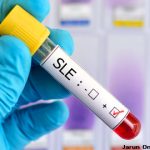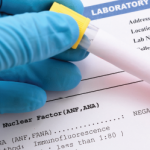For example, if someone has an ANA of 1:80 in the setting of mild fatigue and arthralgias without arthritis, the post-test probability for a SARD is very low—but not impossible. However, a patient with severe fatigue, inflammatory polyarthritis and thrombocytopenia with an ANA of 1:1,280 would have a very high likelihood. A negative ANA for the former patient would essentially rule out the possibility of SLE. Yet, a negative ANA by IFA for the latter patient makes SLE less likely but should be followed by further testing (e.g., by ordering an ANA by solid phase assay, anti-SSA, anti-dsDNA and assessing for cellular-bound complement activation products, such as EC4d and BC4d).11
The EULAR/ACR 2019 SLE classification criteria requires a positive ANA on HEp-2 cells by IFA of at least 1:80, which has a high sensitivity of 97.8%.10 However, the sensitivity is not 100%. Some labs define a positive ANA as being at least 1:40, and there are SLE patients whose ANA is 1:40.
It is important to exercise caution when considering SLE with an ANA of 1:40 to 1:80. Thirteen percent of healthy people are positive at this level and higher.5 Noting the patient’s phenotype (clinical manifestations) to drive the workup and final diagnosis is of utmost importance.
ANA Patterns
The International Consensus on ANA Patterns working group describes 29 different patterns on ANA IFA testing. These include nuclear, cytoplasmic and mitotic-phase (e.g., centromere pattern) antibodies. Due to high intraobserver variation in pattern identification and the non-specificity of the patterns, pattern identification is rarely useful in clinical practice.
Centromere, followed closely by nucleolar pattern, has the highest predictive value for a SARD. These two patterns are, therefore, most helpful.9 Most patients with centromere titers of 1:640 and higher have SSc, SLE or Sjögren’s disease, while nucleolar pattern is more highly associated with SSc, SLE and inflammatory myositis.
Anti-diffuse fine-speckled (anti-DFS) patterns must be interpreted cautiously because there is more than a 50% variation in inter-technician interpretation. However, if subsequent anti-DFS70 testing by immunoblotting is positive, it may help rule out a SARD if specific autoantibodies are negative.12
The future of ANA IFA pattern assessment appears more promising. Machine learning may help identify specific autoantibodies through pattern assessment.
When to Order ANA
ANA positivity is essential in making a diagnosis of SLE, SSc, mixed connective tissue disease, drug-induced lupus and autoimmune hepatitis.8 Related SARDs, such as Sjögren’s disease and idiopathic inflammatory myositis are also usually ANA positive, but ANA positivity is not essential. However, because the SARDs can cause similar manifestations (e.g., musculoskeletal pain, Raynaud’s, rash, fatigue, cytopenias, and neurologic and cardiopulmonary disease), ordering an ANA when considering any SARD is reasonable.

